I have been, or can be if you click on a link and make a purchase, compensated via a cash payment, gift, or something else of value for writing this post. As an Amazon Associate, I earn from qualifying purchases. Please read my full Affiliate Disclosure for more information.
Ever wondered how a simple change to your living room’s ceiling can completely transform the space? Simple false ceiling designs have become a favorite among homeowners and designers alike, thanks to their ability to add elegance and modernity without overwhelming the room. They offer a clean, uncluttered look that seamlessly blends with various decor styles, making open spaces feel more sophisticated and inviting.
This article is your ultimate source of inspiration, packed with practical ideas to elevate your living area with sleek, minimalist false ceiling designs. Whether you prefer subtle lighting effects, geometric patterns, or natural finishes, you’ll discover a diverse range of options to suit your taste. Get ready to explore ideas that combine style, functionality, and simplicity—perfect for creating open, airy living rooms that impress!
1. Minimalist Drop Ceiling with Hidden LED Lighting
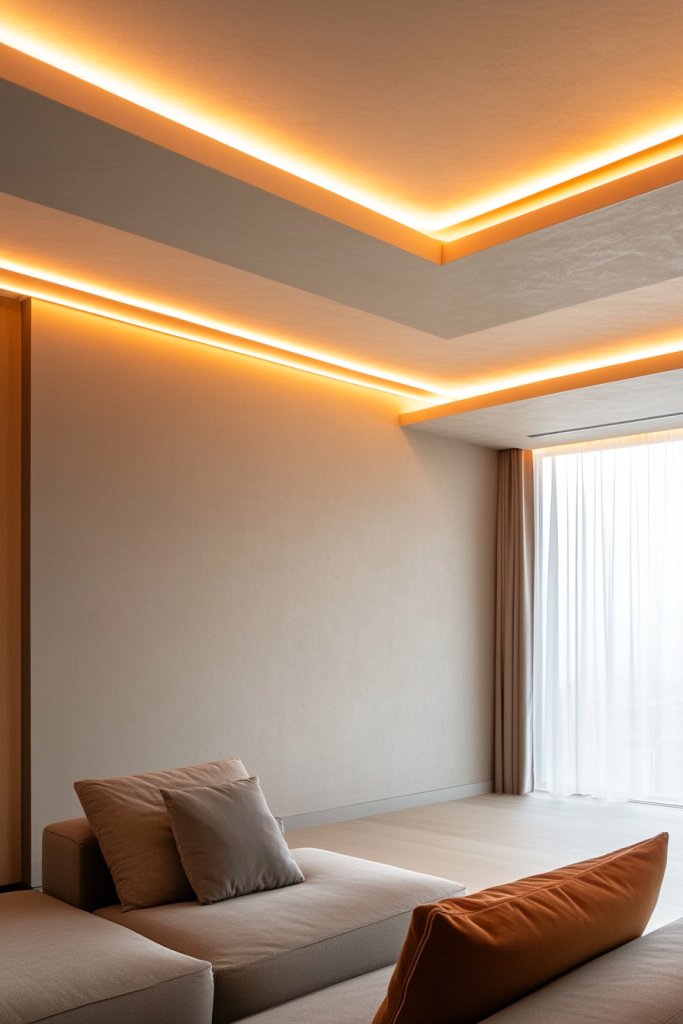
A minimalist drop ceiling with hidden LED lighting is an ingenious way to add subtle sophistication and ambient glow to your living room. This design emphasizes clean lines and unobtrusive features, making your space feel modern and uncluttered.
Imagine a sleek, flat false ceiling painted in crisp white or soft neutral tones, with narrow LED strips embedded just beneath the edges or within recessed channels. When lit, these strips cast a gentle, diffuse glow that softens the room’s atmosphere, creating a warm, inviting environment.
The concealed lighting ensures no visible fixtures, keeping the ceiling looking seamless and tidy. The overall effect is a contemporary, airy space that emphasizes simplicity while adding a touch of luxury.
Getting started is straightforward. You’ll need a flat false ceiling framework, recessed LED strip lighting, and appropriate diffusers or trims for a clean finish.
First, install the drop ceiling framework securely, ensuring it’s level. Then, embed the LED strips into narrow channels or along the perimeter, wiring them to a dimmer switch for adjustable lighting.
Finish with a smooth coat of paint matching your walls for a cohesive look. This setup is perfect for beginners or DIY enthusiasts aiming for a sleek, modern aesthetic without complex detailing.
2. Coffered Ceiling Design for Elegant Depth
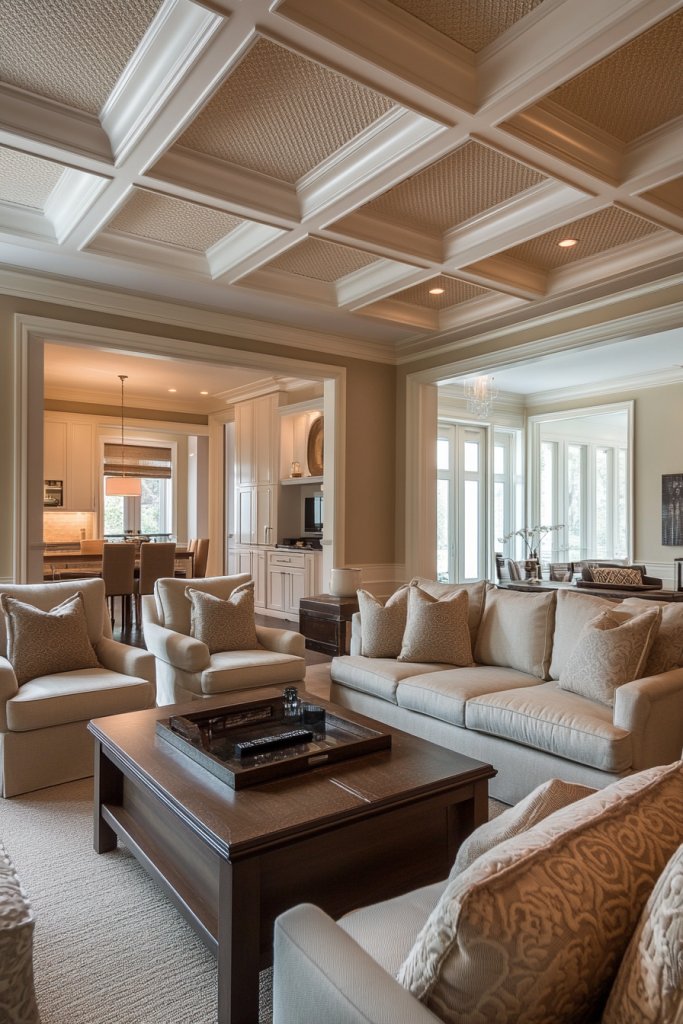
A coffered ceiling introduces subtle architectural depth and elegance, transforming a simple living room into a sophisticated retreat. This classic design features a grid of sunken panels, adding texture and visual interest without overwhelming the space.
Visualize a ceiling divided into a series of square or rectangular recessed panels framed by slim wooden or plaster moldings. These panels are often painted in a soft shade like cream, light gray, or muted pastel to maintain a clean look.
The borders of each panel might have a slight bevel or be highlighted with contrasting colors for emphasis. The overall effect is a structured, geometric pattern that draws the eye upward, giving the illusion of height and grandeur.
When lit with soft, indirect lighting or spotlights, the coffered pattern becomes even more prominent and inviting. To implement this, you’ll need wooden or plaster moldings, joint compound or plaster, and paint in coordinating shades.
Start by planning your grid layout and marking it precisely on the ceiling. Attach the moldings securely, creating the grid pattern, then fill any gaps with joint compound.
Once dry, sand smoothly and paint the entire surface. For added depth, install hidden LED strip lights along the borders or spotlights directed into each panel. This design suits DIYers with some carpentry experience or professionals seeking a timeless, elegant feature.
3. Layered False Ceiling with Contrasting Colors
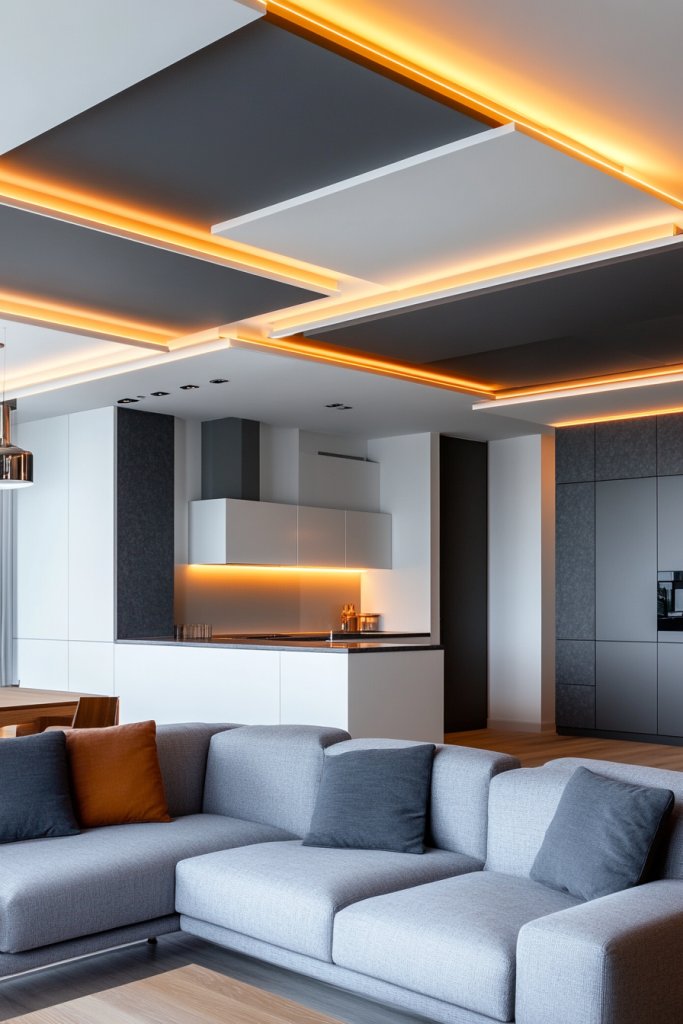
Layered false ceilings with contrasting colors are a fantastic way to define different zones within an open living space, adding depth and visual separation without walls. This approach creates a dynamic, modern look that enhances spatial flow.
Recommended Products to replicate this idea
| # | Preview | Product | |
|---|---|---|---|
| 1 |

|
Usg 3270 SheetrockTM Ceiling, Gypsum Panel, 48" x 24", White | Check Latest Price |
| # | Preview | Product | |
|---|---|---|---|
| 1 |

|
Barrina (6 Pack LED T5 Integrated Single Fixture, 4FT, 2200lm, 6500K Super Bright White, 20W... | Check Latest Price |
Picture a ceiling comprising two or more levels, with the lower layer painted in a soft, neutral tone like beige or off-white, and the upper layer in a darker, contrasting shade such as charcoal gray or navy. The edges of the upper layer are crisp and sharply defined, creating an eye-catching border.
These layers can be straight or curved, depending on your style, and can incorporate recessed lighting or cove lighting along the junctions. The contrast accentuates the layered structure, guiding your eye through different functional zones—like a cozy seating nook and an open entertainment area—while maintaining harmony.
To bring this idea to life, you’ll need gypsum boards or false ceiling panels, paint in contrasting shades, and lighting fixtures such as LED strips or spotlights. Begin by dividing the ceiling into sections, then construct the layered levels using gypsum boards.
Finish the edges neatly and paint each layer separately. Incorporate concealed LED lighting or cove lights to highlight the layers at night. This design is perfect for homeowners ready to experiment with bold contrasts and modern spatial arrangements, and it’s achievable with basic carpentry and painting skills.
4. Linear Panel Ceiling with Wood Finish

A linear panel ceiling with a wood finish introduces warmth and a contemporary touch to your living room, blending natural textures with sleek design. It’s an elegant way to add character without clutter.
Recommended Products to replicate this idea
| # | Preview | Product | |
|---|---|---|---|
| 1 |

|
Yuzzy Wood Panels for Wall and Ceiling - 108 x 11 Inch Wood Slat Acoustic Panels 4 PCS - Modern... | Check Latest Price |
| # | Preview | Product | |
|---|---|---|---|
| 1 |

|
KSIPZE 100ft Led Strip Lights RGB Music Sync Color Changing Bluetooth Led Lights with Smart App... | Check Latest Price |
Envision long, slim ceiling panels made of natural wood or wood-effect laminate arranged in parallel lines across the ceiling, creating a streamlined, minimalist look. The wood’s rich grains and warm tones—like oak, teak, or walnut—bring a cozy, inviting feel, contrasting beautifully with neutral or pastel wall colors.
The narrow gaps between the panels enhance the linear aesthetic and can be subtly lit with concealed LED strips to add depth and softness. This design emphasizes clean, straight lines and a sense of order, making the space feel larger and more connected.
To implement, gather wooden or wood-look laminate panels, metal or wooden trims, and LED strip lights. Start by fixing the panels onto a sturdy false ceiling framework, ensuring they are evenly spaced.
Secure the panels, then finish with a clear protective coat if using natural wood. Install concealed lighting along the gaps or edges for a refined glow. This style suits those seeking a modern yet warm ambiance and can be achieved by DIY enthusiasts familiar with basic carpentry and electrical work.
5. False Ceiling with Cove Lighting for Soft Ambience

A false ceiling with cove lighting creates a soothing, luxurious atmosphere perfect for relaxing or entertaining. The gentle indirect light enhances the room’s mood and adds a subtle architectural feature.
Recommended Products to replicate this idea
| # | Preview | Product | |
|---|---|---|---|
| 1 |

|
KSIPZE 100ft Led Strip Lights RGB Music Sync Color Changing Bluetooth Led Lights with Smart App... | Check Latest Price |
| # | Preview | Product | |
|---|---|---|---|
| 1 |

|
Monoprice False Ceiling Equipment Storage Enclosure - Ideal for A/V Equipment, 2 Feet x 2 Feet,... | Check Latest Price |
Imagine a curved or straight false ceiling with a recessed cove along its perimeter, lined with LED strips or strip lights. When illuminated, the cove casts a soft, diffused glow that reflects off the ceiling and walls, enveloping the space in a warm, inviting hue.
The design might feature a smooth, flat surface with a rounded edge or a layered structure with a slight drop, emphasizing the elegance of the lighting. The ambient light reduces harsh shadows, making the living room feel more spacious and cozy.
Getting started involves installing a simple flat false ceiling, creating a cove using plaster or PVC molding, and embedding LED strip lights inside the cove. Secure the ceiling framework first, then construct the cove edge, ensuring it’s smooth and even.
Paint the ceiling in a neutral tone to enhance light reflection. Finally, run the LED strips into the cove, connect them to a dimmer or remote control, and enjoy the calming glow. This design is accessible for DIYers and adds a touch of understated elegance to any open living space.
6. Drop Ceiling with Acoustic Panels for Sound Control
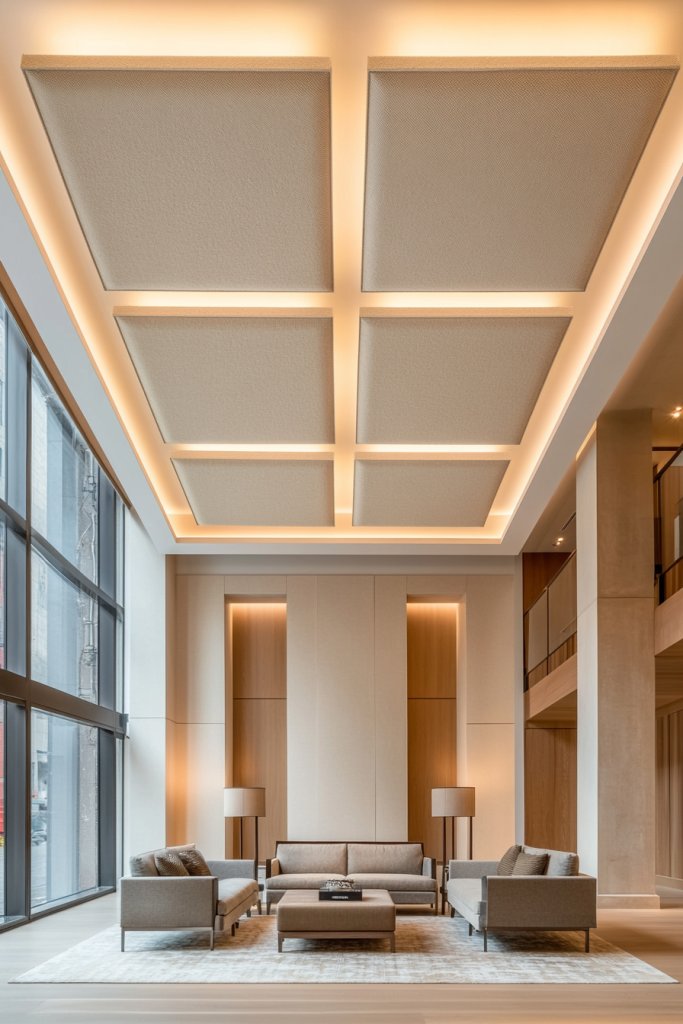
Creating a drop ceiling with acoustic panels is a smart way to improve sound quality in your living room while keeping a sleek, modern look. This idea is especially valuable in open spaces where noise can echo or become overwhelming, making your space more comfortable and functional.
Recommended Products to replicate this idea
| # | Preview | Product | |
|---|---|---|---|
| 1 |

|
24 Pack-12 x 12 x 2 Inches Pyramid Designed Acoustic Foam Panels, Sound Proof Foam Panels Black,... | Check Latest Price |
| # | Preview | Product | |
|---|---|---|---|
| 1 |

|
Muzata 64 Sq Ft Drop Ceiling Gird System White Complete Set Galvanized Steel Grid Kit Easy... | Check Latest Price |
It combines practicality with style, ensuring your living room feels cozy and peaceful. Visually, this design features a clean, flat false ceiling with strategically placed rectangular or square acoustic panels.
These panels are usually covered in fabric or soft materials that blend seamlessly with the ceiling’s surface, often matching neutral tones like beige, gray, or soft pastels. The panels can be arranged in a grid or linear pattern, adding subtle visual interest without clutter.
The overall effect is a sophisticated, streamlined ceiling that absorbs sound while maintaining an unobtrusive aesthetic. When lit with warm, indirect lighting, the panels’ textures add depth and tactile appeal, creating a calm, inviting atmosphere.
To implement this idea, start by measuring your ceiling space and choosing the right acoustic panels—foam, textile-covered, or mineral fiber options work well. You’ll need a drop ceiling framework, which can be installed with basic tools like a drill, level, and measuring tape.
Arrange the panels in a grid pattern, leaving space for lighting if desired, and secure them with mounting clips or adhesive. For a beginner-friendly approach, opt for pre-cut panels and simple mounting systems. This project can be completed over a weekend with minimal fuss, transforming your open living area into a quieter, more intimate space.
7. Geometric Patterned False Ceiling for Visual Interest

Adding a geometric pattern to your false ceiling instantly elevates your living room’s style, turning a simple surface into a focal point. This idea is perfect for those who want to introduce modern, eye-catching detail without overwhelming the space.
It’s a creative way to add personality while keeping the design clean and minimal. Imagine a ceiling with crisp, clean lines forming triangles, squares, or hexagons, carefully arranged to create repeating patterns that catch the eye.
The patterns can be painted in contrasting shades—like crisp white with charcoal gray or soft pastel hues—adding visual depth while maintaining simplicity. The geometric shapes can be slightly raised or recessed, creating subtle shadows and a sense of dimension.
The overall look is sleek, contemporary, and structured, with the pattern serving as a statement feature that complements your furniture and decor. To bring this idea to life, start by sketching your preferred geometric pattern on paper or using design software.
Use painter’s tape to outline the shapes on your ceiling for precision. Paint within the taped sections using high-quality ceiling paint in your chosen colors, or alternatively, install lightweight panels or wallpaper with geometric motifs for a textured effect.
Keep the pattern simple and avoid cluttering with too many colors or intricate details for a clean, modern vibe. This approach is budget-friendly and adaptable, perfect for DIY enthusiasts eager to add a stylish twist to their open living spaces.
8. Plain Suspended Ceiling with Recessed Spotlights
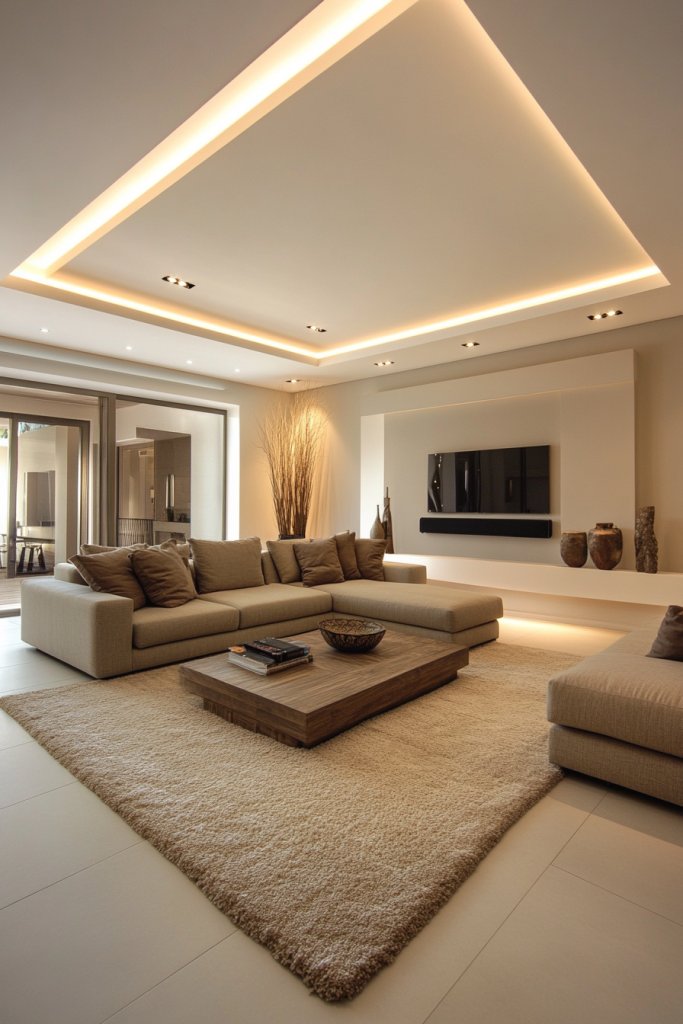
A plain suspended false ceiling with recessed spotlights offers a timeless, minimalist look that enhances any living room. This design emphasizes clean lines and unobtrusive lighting, making the space feel open, airy, and sophisticated.
Recommended Products to replicate this idea
| # | Preview | Product | |
|---|---|---|---|
| 1 |

|
Amico 12 Pack 6 Inch 5CCT Ultra-Thin LED Recessed Ceiling Light with Junction Box, 1050LM... | Check Latest Price |
| # | Preview | Product | |
|---|---|---|---|
| 1 |

|
Muzata 64 Sq Ft Drop Ceiling Gird System White Complete Set Galvanized Steel Grid Kit Easy... | Check Latest Price |
It’s an ideal choice for those who prefer understated elegance without sacrificing functionality. Visualize a smooth, flat ceiling painted in soft, neutral tones like warm white or light gray.
Embedded into the ceiling are small, round spotlights arranged in a balanced pattern—whether in a line, grid, or subtle cluster. These spotlights cast focused, adjustable beams of light that highlight specific areas, such as a cozy reading nook or a decorative centerpiece.
The overall effect is a sleek, seamless surface that amplifies the sense of space and allows for versatile lighting options. When combined with a light-colored palette, it makes the room appear brighter and more inviting.
For easy installation, measure your ceiling and mark the positions for the spotlights, ensuring even spacing. Use a drill to create holes and insert the fixtures, connecting them to your existing electrical wiring—consider hiring a professional if you’re unfamiliar with electrical work.
Choose LED recessed lights for energy efficiency and long life. Finish by painting the ceiling in your preferred color, and add dimmers if you want adjustable ambiance. This straightforward project can be completed in a few hours, transforming your open living room into a sleek, well-lit environment.
9. Beamed False Ceiling with Minimalist Design
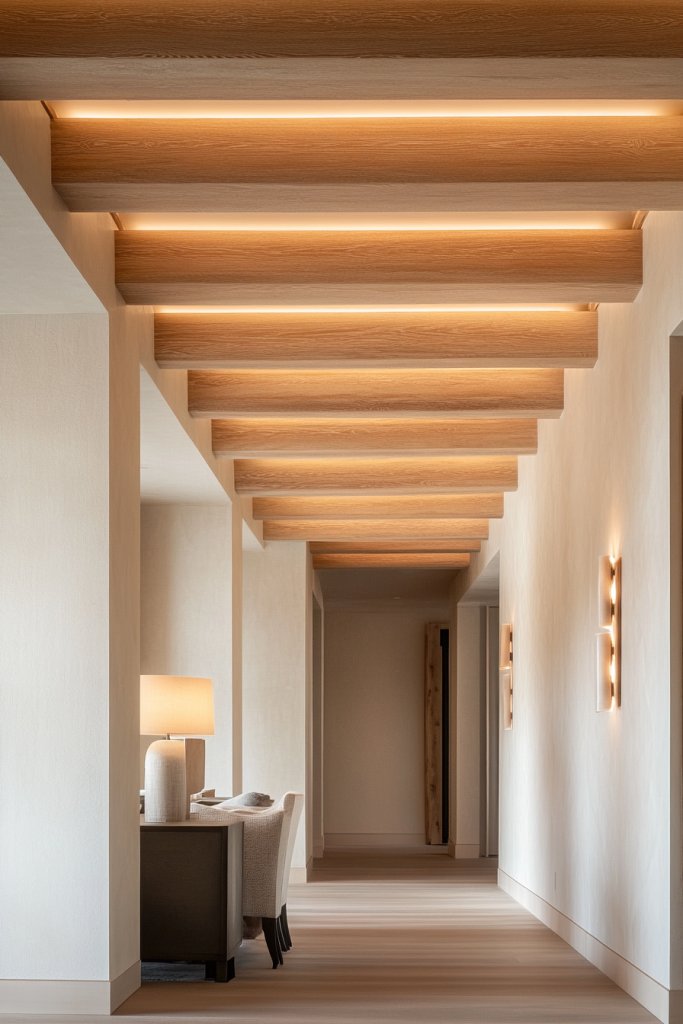
A beamed false ceiling introduces a subtle architectural element that adds warmth and character to an open living space. This idea works beautifully in modern or Scandinavian styles, providing a balanced blend of structure and simplicity.
Recommended Products to replicate this idea
| # | Preview | Product | |
|---|---|---|---|
| 1 |

|
Two Wooden Beams | Check Latest Price |
| # | Preview | Product | |
|---|---|---|---|
| 1 |

|
Amazon Basics Ceiling-Mount Bracket Set, 4-Pack, Black | Check Latest Price |
It creates a sense of definition and coziness without overwhelming the room’s openness. Picture slim, straight wooden beams running parallel or perpendicular across the ceiling, painted in soft, neutral shades like whitewashed oak or light walnut.
The beams are minimal in thickness, emphasizing clean lines and understated elegance. The space between the beams is left plain or filled with a smooth, matte finish ceiling in a matching or contrasting color.
The beams add visual interest and a hint of rustic charm, making the space feel grounded and inviting. When paired with warm lighting or pendant fixtures, the beams enhance the overall ambiance, making the room feel both spacious and cozy.
To implement, measure and mark the placement of your beams, ensuring even spacing for a balanced look. Use lightweight wood or MDF for easy handling, and secure the beams to the ceiling joists or brackets with screws.
Finish with paint or stain to match your decor. For a minimalist look, keep the beams thin and simple—avoid ornate detailing. This project can be a weekend DIY, adding architectural depth with minimal effort, and creating a warm, inviting atmosphere in your living room.
10. Mirrored False Ceiling to Enhance Space and Light
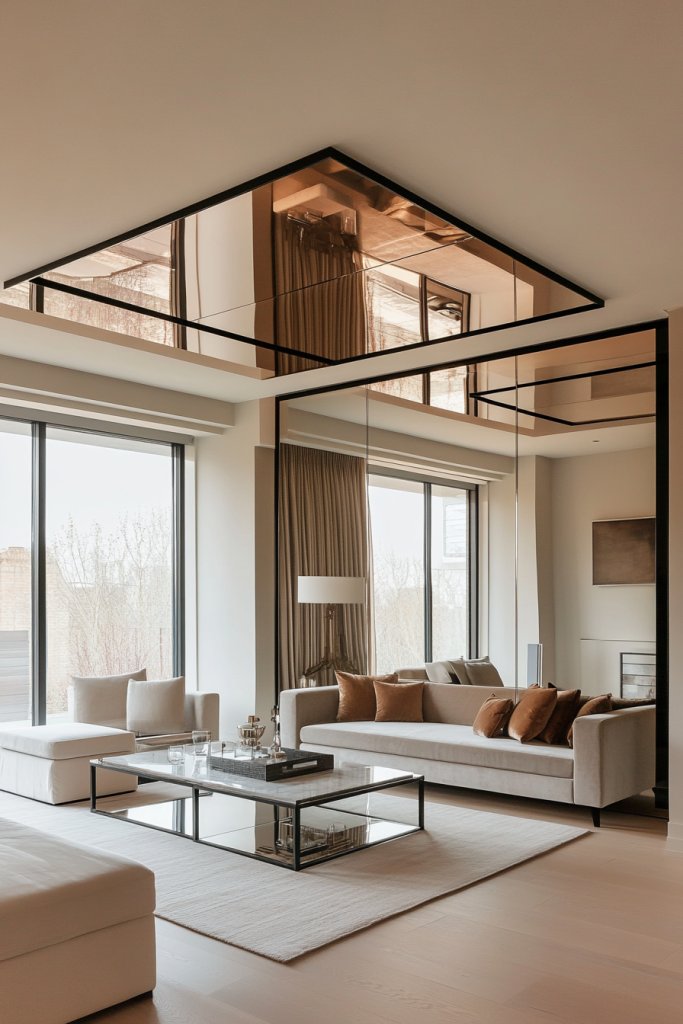
A mirrored false ceiling is a striking design choice that visually doubles the height of your living room and amplifies natural and artificial light. This innovative idea brings modern glamour and a sense of openness, making it especially appealing for smaller or darker spaces.
Recommended Products to replicate this idea
| # | Preview | Product | |
|---|---|---|---|
| 1 |

|
Ruomeng Home Gym Mirrors 12 Inch x 12Pcs Wall Mounted Mirror Glass Frameless Full Length Mirror... | Check Latest Price |
| # | Preview | Product | |
|---|---|---|---|
| 1 |

|
MHMYDZ 1000 lb Capacity Heavy Duty Hammock Hanging kit Ultra Durable Hooks Carabiners for Hammock... | Check Latest Price |
It transforms your ceiling into a reflective surface that bounces light around the room, creating a bright, airy environment. Envision a ceiling finished with sleek, large mirror panels or reflective acrylic sheets, carefully installed to appear seamless.
The reflective surface gleams softly under ambient lighting, and the edges are neatly framed for a polished look. When combined with recessed lighting or pendant lamps, the mirror surface intensifies the glow, making the space seem larger and more inviting.
The mirror’s reflective quality also adds depth and texture, subtly elevating the overall aesthetic with a modern, luxurious touch. To create this effect, select high-quality mirror panels or acrylic sheets cut to fit your ceiling dimensions.
Use a strong, mirror-safe adhesive or mounting system designed for ceilings to ensure secure installation. Finish the edges with minimal framing or concealed trims for a clean look.
Be cautious of safety and ensure the mirror is securely anchored. This project is straightforward for DIYers with some experience, and it’s an excellent way to add a wow factor while enhancing the light and space in your open living room.
11. Textured False Ceiling with Subtle Patterns

Adding a textured false ceiling with subtle patterns instantly elevates a simple ceiling into a refined design feature that adds depth and tactile interest. This approach works beautifully in open living spaces, where minimalism meets elegance, giving the room a sophisticated yet understated look.
Recommended Products to replicate this idea
| # | Preview | Product | |
|---|---|---|---|
| 1 |

|
24 Pack-12 x 12 x 2 Inches Pyramid Designed Acoustic Foam Panels, Sound Proof Foam Panels Black,... | Check Latest Price |
| # | Preview | Product | |
|---|---|---|---|
| 1 |

|
Ceiling Decor Film - White PVC Stretch Ceiling - Room Covering Kit, DIY Installation for Modern... | Check Latest Price |
It’s especially effective in neutral color palettes, allowing the textures to become the focal point without overwhelming the overall decor. Imagine a ceiling finished with a gentle, embossed wave pattern or a soft, linen-like fabric texture in a matte white or soft beige.
The subtle patterns create a visual play that catches the light differently throughout the day, adding warmth and dimension to the room. The textures can be achieved through materials like textured plaster, decorative wall panels, or lightweight fabric coverings stretched across the ceiling surface.
The tactile appeal invites a calming, cozy ambiance, perfect for relaxing living rooms. To recreate this look, start by choosing a textured material such as acoustic panels, decorative plaster, or stretch fabric.
Prepare the ceiling surface and fix the panels or fabric securely, ensuring smooth, wrinkle-free application. For a DIY-friendly option, opt for peel-and-stick textured wallpaper designed for ceilings, which is easy to install and remove. Keep the color palette simple—soft neutrals or monochrome shades—to maintain the understated elegance that makes this design so timeless.
12. Modular Ceiling with Interlocking Panels
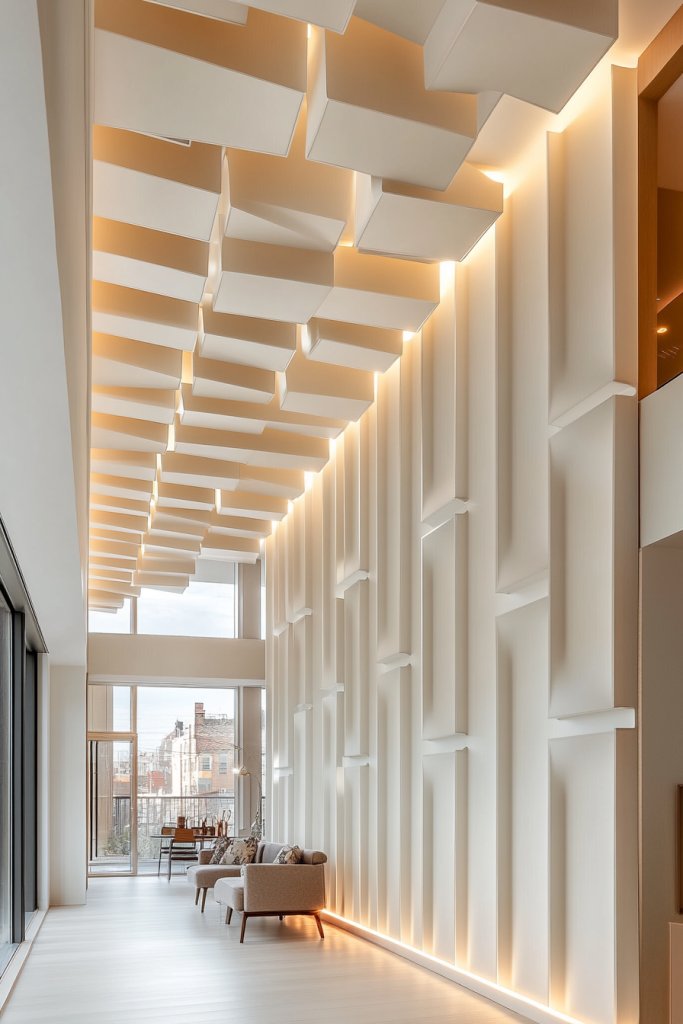
A modular false ceiling with interlocking panels offers a versatile, contemporary solution that allows for easy customization and upgrades. This design is perfect for open-plan living rooms where you want a sleek, uniform look that can be tailored to your style preferences.
Recommended Products to replicate this idea
| # | Preview | Product | |
|---|---|---|---|
| 1 |

|
Art3d PVC Ceiling Tiles, 2'x2' Plastic Sheet in White (12-Pack) | Check Latest Price |
| # | Preview | Product | |
|---|---|---|---|
| 1 |

|
KSIPZE 100ft Led Strip Lights RGB Music Sync Color Changing Bluetooth Led Lights with Smart App... | Check Latest Price |
The modular concept also makes repairs and future modifications straightforward, adding functional value alongside aesthetics. Visualize a ceiling made up of large, rectangular or square panels in matte or semi-gloss finishes, arranged in a grid pattern.
The panels can be in contrasting shades like warm wood tones with crisp white borders or monochrome hues for a minimalist vibe. The interlocking system ensures a seamless, clean appearance, with hidden joints that give a crisp, modern finish.
You might add LED strips along the panel edges for indirect lighting, enhancing the modular design’s visual appeal. To implement, select modular ceiling panels made from materials like PVC, plasterboard, or wood veneer—these are lightweight and easy to work with.
Measure your ceiling space carefully, then plan the layout, ensuring panels fit snugly. Use an interlocking mounting system and attach panels securely to a grid framework or directly to the ceiling. For a DIY approach, pre-cut panels and a simple grid system can be assembled with basic tools, making this an accessible upgrade for most homeowners.
13. Floating Ceiling with Hidden Support Structures
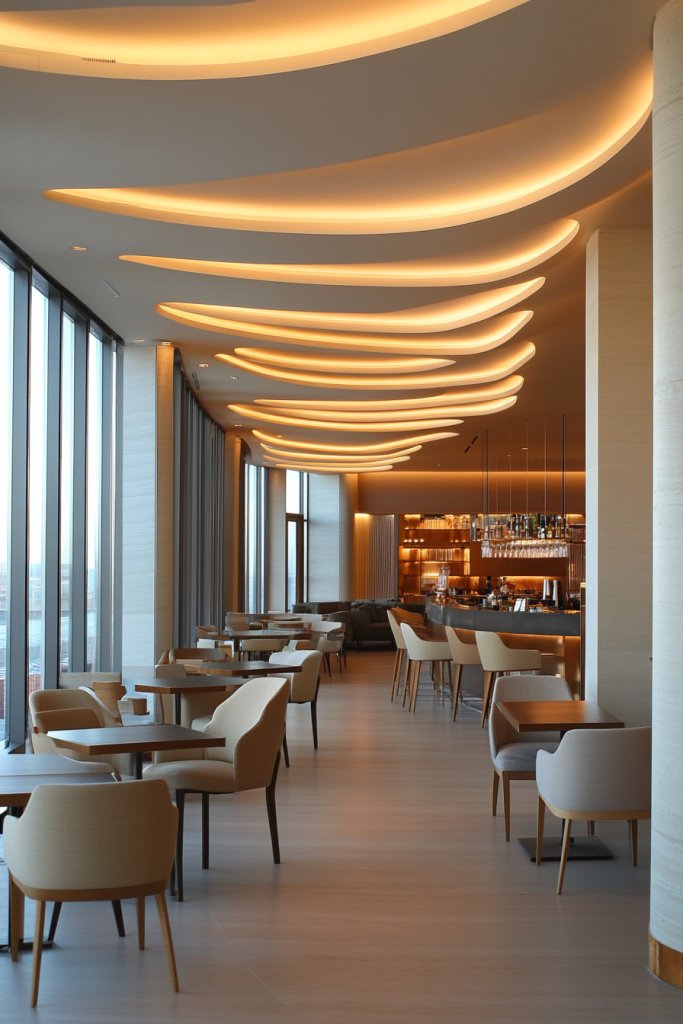
Creating a floating ceiling with hidden support structures offers a sleek, modern aesthetic that appears to hover above the room, making the space feel larger and more open. This design minimizes visual clutter by concealing the framing and support elements, emphasizing clean lines and smooth surfaces.
Recommended Products to replicate this idea
| # | Preview | Product | |
|---|---|---|---|
| 1 |

|
Amylove Drywall Repair Panel Drywall Patch Panel Repair for Mend Wall(2 Pcs,Green,12 x 12 x 1/2... | Check Latest Price |
| # | Preview | Product | |
|---|---|---|---|
| 1 |

|
KSIPZE 100ft Led Strip Lights RGB Music Sync Color Changing Bluetooth Led Lights with Smart App... | Check Latest Price |
It’s an ideal choice for contemporary living rooms seeking a minimalist, high-end look. Picture a ceiling with a slight gap from the actual structural ceiling, achieved through concealed support beams or hidden mounting brackets.
The surface itself might be finished in smooth plaster, painted in a soft neutral tone like off-white or light gray, enhancing the floating illusion. Indirect lighting, such as LED strips hidden along the perimeter or within the gap, can accentuate the floating effect and add a warm glow to the space, making it inviting and sophisticated.
For installation, start by designing a discreet support framework using metal or wooden supports hidden within the ceiling cavity. Attach a smooth drywall or plasterboard ceiling surface over the support structure, ensuring all hardware is concealed.
Use lightweight materials for the ceiling surface to facilitate easier installation. Incorporate LED strip lighting along the edges before finishing to achieve the floating effect. This approach requires some basic carpentry skills but is achievable with patience and careful planning.
14. Simple Tray Ceiling with Recessed Edging
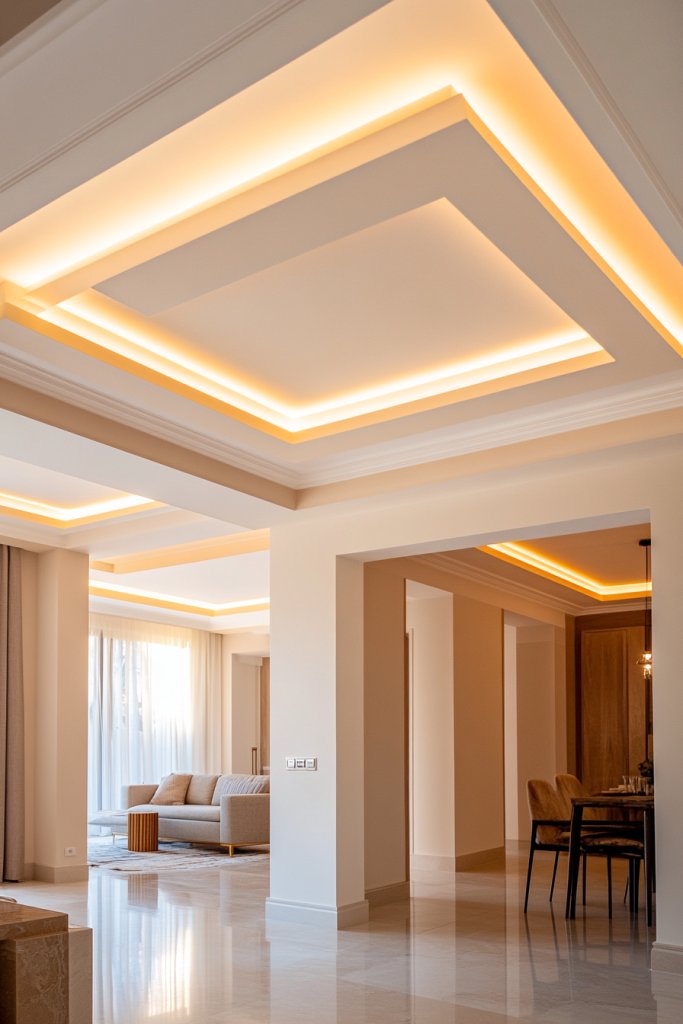
A tray ceiling with recessed edging introduces subtle architectural interest that enhances the room’s vertical dimension without overwhelming the space. It’s a timeless design that adds depth and elegance, perfect for open living rooms that benefit from a touch of classic refinement.
Recommended Products to replicate this idea
| # | Preview | Product | |
|---|---|---|---|
| 1 |

|
10-Pack 6.6ft/2Meter Silver Recessed LED Aluminum Channel for LED Strip Lights Diffuser Channel... | Check Latest Price |
| # | Preview | Product | |
|---|---|---|---|
| 1 |

|
DEKEones Drywall Skimming Blade Set with Portable Case, Stainless Steel 6", 10",16", 24"&32"... | Check Latest Price |
The recessed border creates a layered look, making the ceiling appear taller and the space more expansive. Visualize a ceiling with a central flat panel, framed by a narrow, recessed border or ledge.
The border can be finished in a contrasting color—like a soft gray or warm beige against a white ceiling—or in a different material such as wood veneer for added warmth. The main tray section remains smooth, while the recessed edges can be highlighted with subtle lighting or a slightly darker shade to emphasize the layered effect.
This design offers a refined, understated aesthetic that pairs well with both modern and traditional decor. To build, start by marking the outline of the tray on the ceiling, then install a secondary framework or drop ceiling to create the recessed border.
Use drywall or plasterboard to form the tray shape, ensuring smooth, clean edges. Finish with paint or wallpaper to match or contrast with the main ceiling.
For lighting, install LED strip lights along the recessed border or spotlights directed inward to accentuate the layered look. This approach is straightforward and adds a sophisticated architectural feature with minimal effort.
15. Monochrome Ceiling with Matte Finish
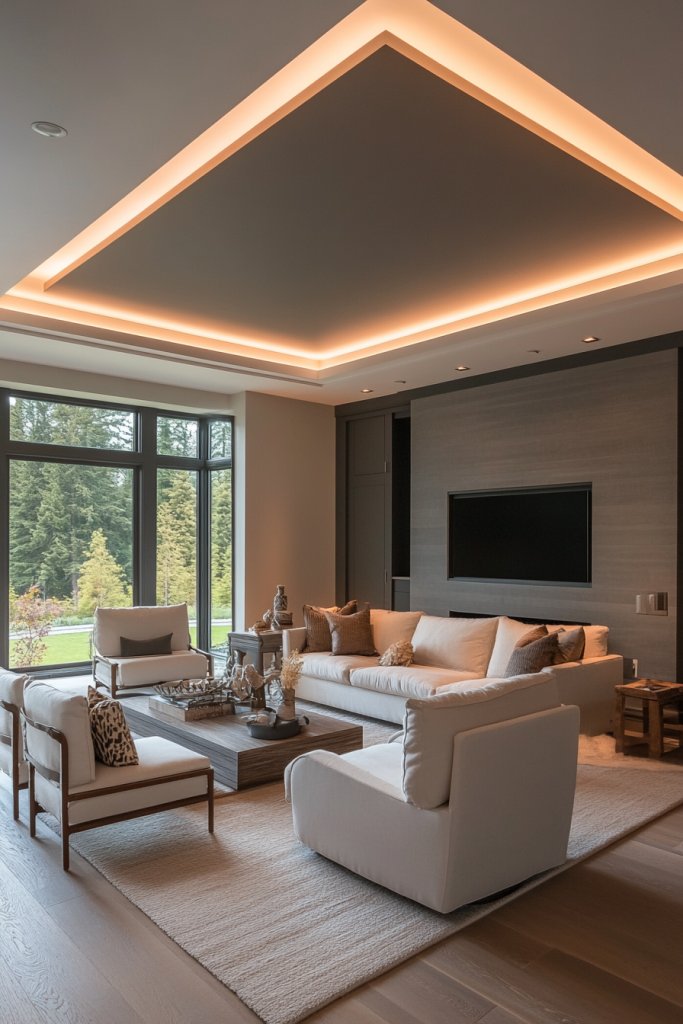
A monochrome ceiling with a matte finish offers a sleek, seamless look that blends effortlessly with the overall room decor, creating a calming, cohesive environment. This design is especially appealing in open spaces where simplicity and elegance are desired, and it allows other design elements like furniture and textiles to stand out.
The matte texture also reduces glare, adding to the room’s cozy, inviting feel. Picture a ceiling painted in a single, soft shade such as warm white, taupe, or dove gray.
The matte finish absorbs light rather than reflecting it, lending a subtle, velvety appearance that feels modern and refined. This understated look enhances the room’s sense of space and calm, providing an ideal backdrop for layered textures like plush cushions, textured throws, or woven rugs.
It’s a versatile choice that pairs well with natural materials and minimalist decor. To achieve this, select high-quality matte ceiling paint in your preferred color.
Prepare the ceiling surface by cleaning and patching any imperfections. Use painter’s tape for clean edges around the perimeter.
Apply two thin coats for even coverage, allowing proper drying time. For a more polished look, consider using a roller for large areas and a brush for edges. This simple, cost-effective update instantly elevates your living room’s aesthetic while maintaining a clean, cohesive atmosphere.
16. Slim Frame Ceiling with Integrated Ventilation
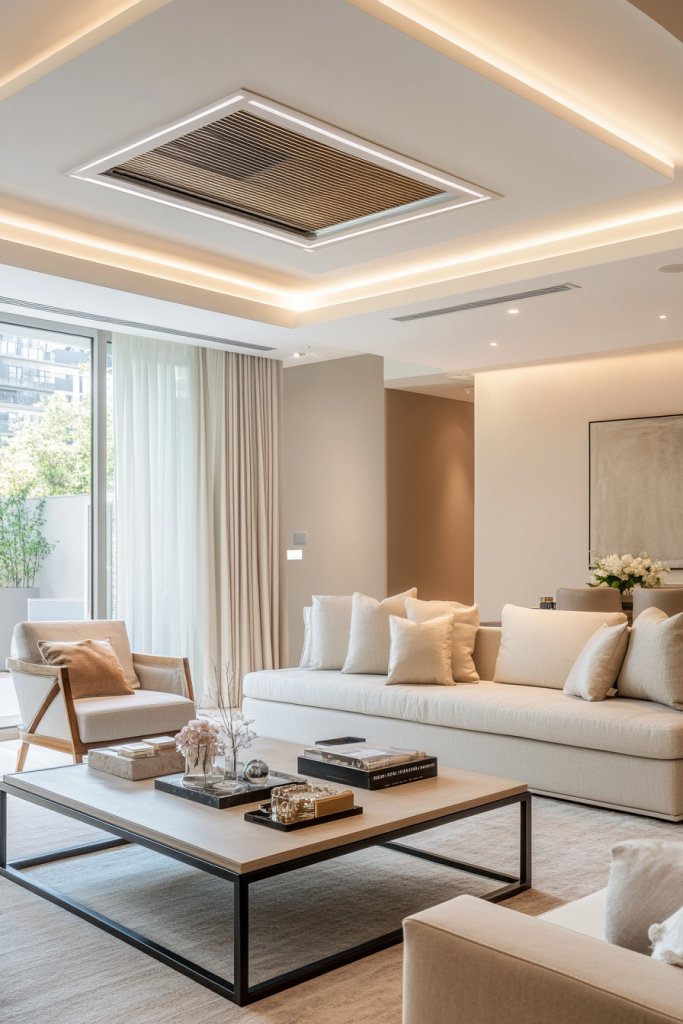
Adding a slim frame ceiling with integrated ventilation offers a sleek way to blend functionality with modern design. This approach ensures proper air circulation without disrupting the room’s minimalist aesthetic, making it perfect for open living spaces where airflow is key.
Recommended Products to replicate this idea
| # | Preview | Product | |
|---|---|---|---|
| 1 |

|
EZ-FLO 10 x 6 Inch (Duct Opening) Air Vent Cover for Wall or Ceiling, Three-Way Ventilation... | Check Latest Price |
| # | Preview | Product | |
|---|---|---|---|
| 1 |

|
Monoprice False Ceiling Equipment Storage Enclosure - Ideal for A/V Equipment, 2 Feet x 2 Feet,... | Check Latest Price |
It subtly combines architectural interest with practical needs, keeping the ceiling clean and unobtrusive. Visualize a narrow, matte black or white frame running along the perimeter of your ceiling, with slim ventilation grilles seamlessly embedded within.
The frame’s edges are sharp yet refined, creating a subtle boundary that defines the space while maintaining a clutter-free look. The vents are discreet, almost invisible, allowing the focus to stay on the simple, elegant lines of the ceiling.
The overall effect is a contemporary, functional centerpiece that enhances the room’s air quality without drawing attention away from other decor elements. To implement this design, start by measuring your ceiling’s perimeter to determine the length of the slim frame needed.
Choose materials such as aluminum, PVC, or wood—with powder-coated finishes for durability and a clean look. Install a basic false ceiling structure first, then affix the slim frame around the edges, ensuring the ventilation grilles are integrated into the frame.
For beginners, using pre-made trim or molding can simplify installation. Finish by painting the entire ceiling in your preferred shade—white or soft neutrals work best for a minimalist feel—and connect the ventilation system according to manufacturer instructions.
17. Customizable LED Panel Ceiling for Dynamic Lighting
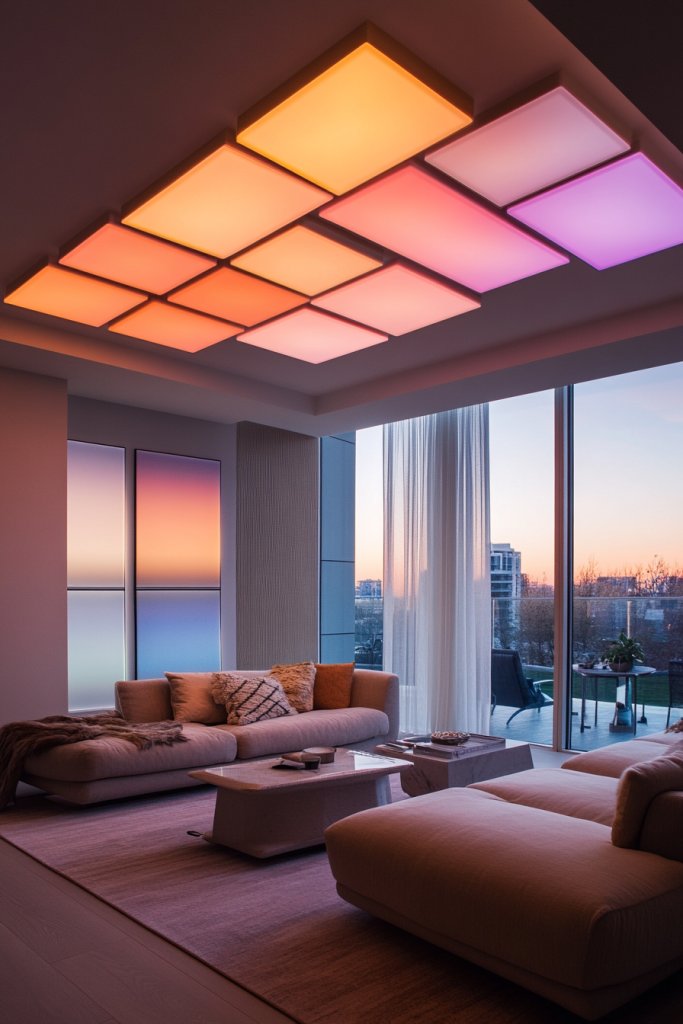
A customizable LED panel ceiling transforms your living space into a vibrant, mood-responsive environment with effortless control over lighting color and intensity. Perfect for open-plan living rooms, this idea brings flexibility and a modern touch that adapts to any occasion—whether relaxing, entertaining, or working.
Recommended Products to replicate this idea
| # | Preview | Product | |
|---|---|---|---|
| 1 |

|
Lithonia Lighting CPANL 1x4 LED Flat Panel Light, 1 Ft. x 4 Ft. LED Light Panel, Ceiling Lighting... | Check Latest Price |
| # | Preview | Product | |
|---|---|---|---|
| 1 |

|
LIVE4COOL RGB/RGBW LED Bluetooth Controller RGB LED Strip Light Controller Phone APP Control for... | Check Latest Price |
Imagine sleek, rectangular LED panels fitted flush within the ceiling, with a smooth, matte surface that diffuses light evenly. These panels can display a spectrum of colors, from calming blues and warm ambers to energizing whites, creating a dynamic ambiance.
Controlled via remote or smartphone app, they can shift effortlessly to match your mood or the time of day. The minimal frames around the panels keep the look clean, while the light’s soft glow feels soothing and inviting, enhancing the openness of the space.
To recreate this look, start by selecting LED panel lights designed for ceilings, available in different sizes and color options. Mount the panels into a simple false ceiling grid or directly into the ceiling using adhesive or mounting brackets—many kits are beginner-friendly.
Connect the panels to a compatible control system, following the manufacturer’s instructions for wiring and setup. For a budget-friendly option, opt for RGB LED strips or panels that can be customized with basic remote controls. Finish by painting the ceiling in a neutral tone to maximize the brightness and keep the focus on the lighting effects.
18. False Ceiling with Built-in Speakers for Modern Living
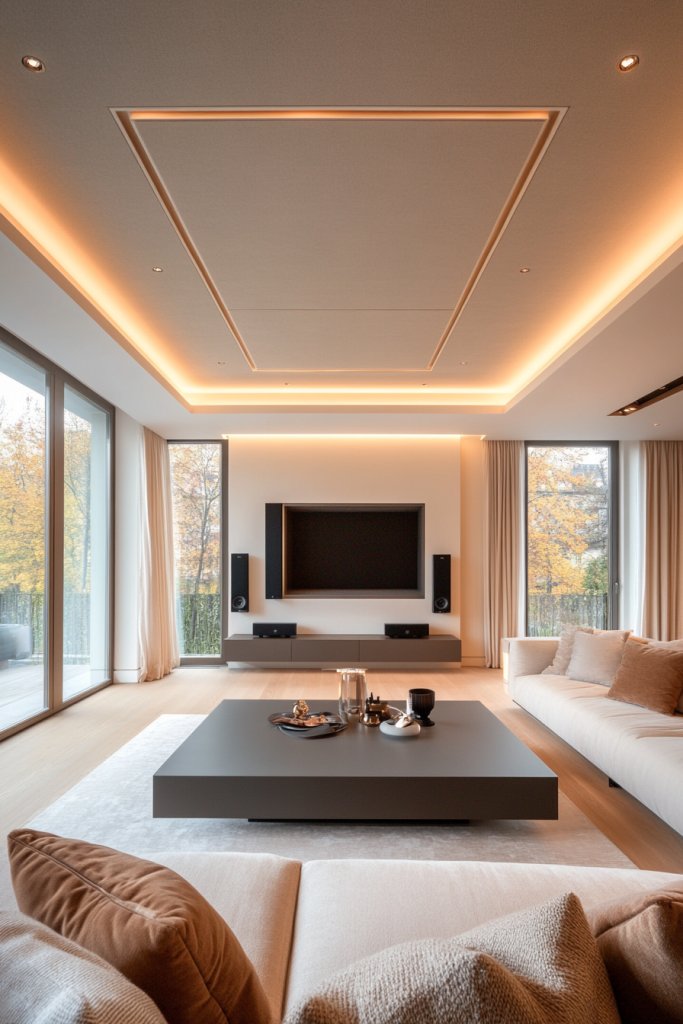
Integrating built-in speakers into your false ceiling elevates your living room into a sleek, tech-savvy space perfect for entertainment and relaxation. It allows you to enjoy high-quality sound without cluttering the room with bulky speakers, maintaining a clean and minimalist look.
Recommended Products to replicate this idea
| # | Preview | Product | |
|---|---|---|---|
| 1 |

|
Polk Audio RC80i 2-Way Premium In Ceiling Speakers 8" Round (Set of 2) Perfect for Damp and Humid... | Check Latest Price |
| # | Preview | Product | |
|---|---|---|---|
| 1 |

|
Daakro AK45 Stereo Audio Amplifier,300W Home 2 Channel Wireless Bluetooth 5.0 Power Amplifier... | Check Latest Price |
Visualize a smooth, flat false ceiling with subtle, round or rectangular speaker grilles flush with the surface. The speakers are discreet, blending seamlessly into the ceiling’s plain surface.
When in use, the room is filled with crisp sound, whether for music, movies, or virtual meetings, creating an immersive experience. The overall aesthetic remains uncluttered, with the focus on your decor and furniture, while the sound system is elegantly hidden.
To implement this, choose in-ceiling speakers suitable for your space, preferably with a neutral, paintable grille. Install the false ceiling first, then cut precise holes where the speakers will go.
Connect the speakers to an amplifier or audio source, following safety and wiring guidelines. For ease of setup, opt for wireless or Bluetooth-enabled speakers that connect directly to your device. After installation, paint the ceiling in your chosen color to match the room’s decor, and enjoy a sleek, integrated sound experience that complements your open living space.
19. Clear Glass or Acrylic False Ceiling for Openness

A clear glass or acrylic false ceiling creates an illusion of endless space, making your living room appear larger and more open. It introduces a modern, airy vibe, especially when paired with ambient lighting, perfect for enhancing open-concept interiors.
Recommended Products to replicate this idea
| # | Preview | Product | |
|---|---|---|---|
| 1 |

|
MSINMKOK Colorful Retro Stained Glass Floral - Fluorescent Light Covers - 2x4 Drop Ceiling... | Check Latest Price |
| # | Preview | Product | |
|---|---|---|---|
| 1 |

|
KSIPZE 100ft Led Strip Lights RGB Music Sync Color Changing Bluetooth Led Lights with Smart App... | Check Latest Price |
Visualize a transparent or semi-transparent ceiling panel that replaces or overlays a traditional false ceiling. When installed, it appears as if the ceiling is floating, with light passing through to create a luminous, spacious feel.
It reflects natural daylight during the day, while at night, subtle lighting from below or integrated LEDs can add a soft glow. The sleek, glossy surface adds a contemporary touch, emphasizing the room’s openness and clean lines, making the space feel brighter and more expansive.
To achieve this look, select tempered glass or acrylic panels with appropriate dimensions for your ceiling. Secure them with concealed mounting brackets or a minimal frame system designed for floating effects.
Seal and finish edges with silicone or lightweight trims to ensure safety and a polished appearance. Incorporate LED strip lighting along the edges or underneath for a luminous effect. For safety and durability, consult professionals for precise measurements and installation, and opt for tinted or frosted options if you want a softer, diffused light and more privacy.
20. Simple Beaded or Linear Ceiling with Metallic Accents
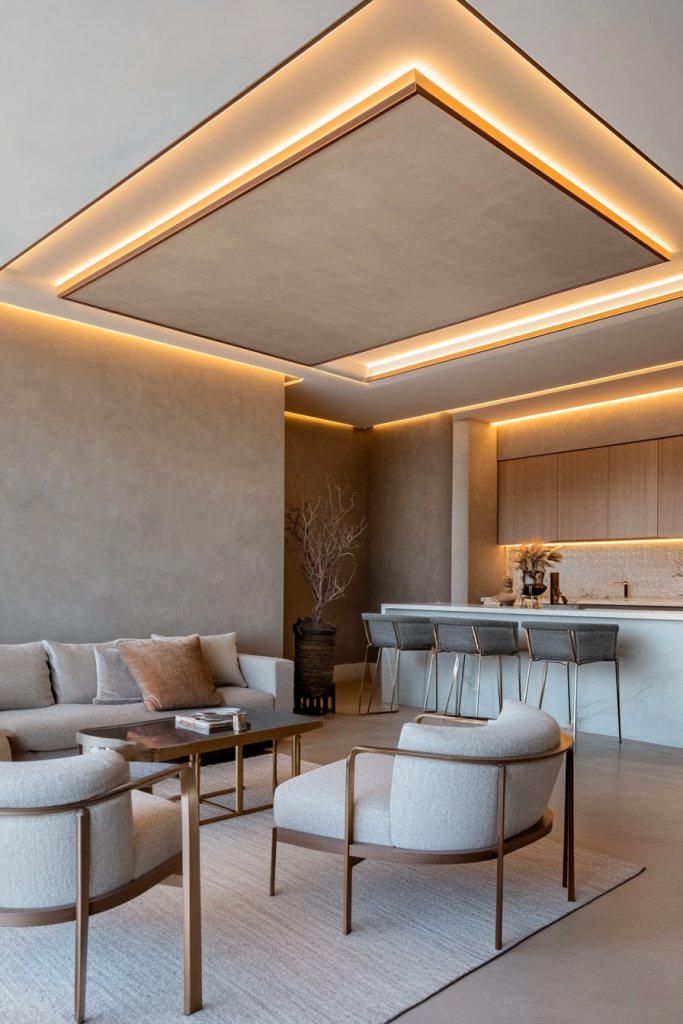
A beaded or linear ceiling with metallic accents offers a subtle yet sophisticated upgrade to your living room, combining minimalist design with elegant detailing. It creates a sense of movement and texture while maintaining a clean, modern aesthetic.
Recommended Products to replicate this idea
| # | Preview | Product | |
|---|---|---|---|
| 1 |

|
Farady Wall Molding Trim Stainless Steel Peel and Stick Mirror-Like Finish Flexible Self Adhesive... | Check Latest Price |
| # | Preview | Product | |
|---|---|---|---|
| 1 |

|
Art3d Fluted Wood Panel for Wall and Ceiling, Beaded Accent Molding for Home Decoration, Pack of... | Check Latest Price |
Visualize a ceiling decorated with narrow, linear beads or strips of metallic finish—either in gold, silver, or brushed copper—laid out in parallel lines or a gentle pattern. The beads catch and reflect light, adding a delicate shimmer that elevates the space without overwhelming it.
The overall design feels refined and understated, perfect for a contemporary open-plan living room where subtle details make a big impact. The metallic accents add warmth or coolness, depending on your choice, blending seamlessly with neutral or bold color palettes.
To create this look, select metallic or beaded ceiling trims available at hardware or specialty stores. Attach them to the ceiling using adhesives or clips, ensuring straight, even lines.
For a simpler approach, use metallic paint or foil strips applied directly onto a flat false ceiling surface to mimic the beaded effect. Keep the design minimal by limiting the number of lines or beads, and complement it with soft lighting—such as recessed or track lights—to highlight the metallic accents. This straightforward DIY project can be achieved with basic tools and materials, transforming your ceiling into a subtle statement piece.
21. Concealed Lighting with Flat False Ceiling Design
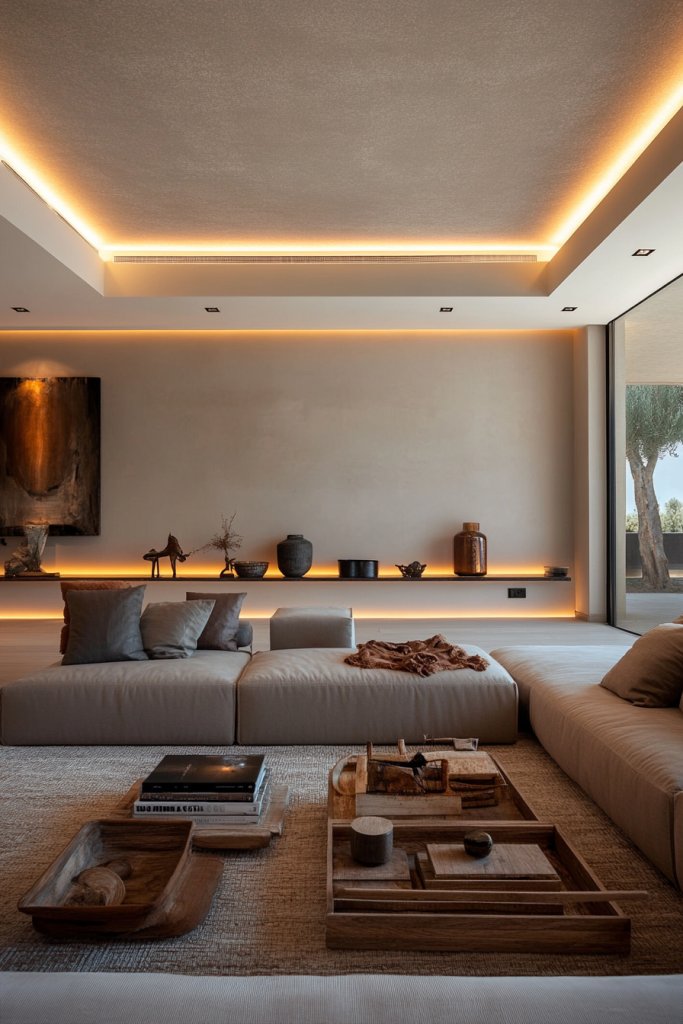
Achieve a modern, clutter-free look with a flat false ceiling that incorporates concealed lighting to create a soft, ambient glow. This design emphasizes a seamless, smooth surface that appears to float within the space, with hidden lighting sources that eliminate visible fixtures.
Recommended Products to replicate this idea
| # | Preview | Product | |
|---|---|---|---|
| 1 |

|
Amico 6 Pack 6 Inch 5CCT Ultra-Thin LED Recessed Ceiling Light with Junction Box,... | Check Latest Price |
| # | Preview | Product | |
|---|---|---|---|
| 1 |

|
Usg 3270 SheetrockTM Ceiling, Gypsum Panel, 48" x 24", White | Check Latest Price |
The indirect illumination enhances the overall mood and makes the room feel more spacious and welcoming. Perfect for contemporary living rooms, this concept combines simplicity with subtle sophistication, transforming your space into a tranquil retreat.
Picture a sleek, unadorned ceiling painted in a crisp white or soft pastel hue, with narrow channels or grooves along the perimeter or within the panels. Embedded LED strip lights or recessed spotlights are concealed within these channels, casting a gentle, even light across the ceiling.
The result is a warm, inviting atmosphere with no visible hardware, allowing other decor elements—like a plush sofa or textured wall finishes—to stand out. The smooth surface and hidden lighting work together to craft a clean, elegant environment perfect for relaxing or entertaining guests.
Implementing this design is simple and adaptable. Begin by installing a flat gypsum or PVC ceiling in your preferred color.
Next, create narrow grooves or channels around the edges or central areas, ensuring they are deep enough to hide your lighting fixtures. Use LED strip lights or recessed downlights designed for such channels, then carefully conceal wiring to maintain a seamless appearance.
Finish with a coat of paint that matches your walls for a cohesive look. With basic tools and patience, you can craft a stunning, modern false ceiling that provides a serene, beautifully lit ambiance.
Conclusion
With a diverse range of clean, simple false ceiling ideas—from minimalist designs and subtle lighting to textured finishes and integrated technology—there’s a perfect option to elevate any open living space. These designs can seamlessly blend style and functionality, transforming your room into a modern, inviting haven.
Don’t hesitate to experiment with these innovative ideas to create a space that reflects your unique taste. Start reimagining your living room today and make your dream interior a reality!
Last update on 2025-09-20 / Affiliate links / Images from Amazon Product Advertising API
Leave a Reply